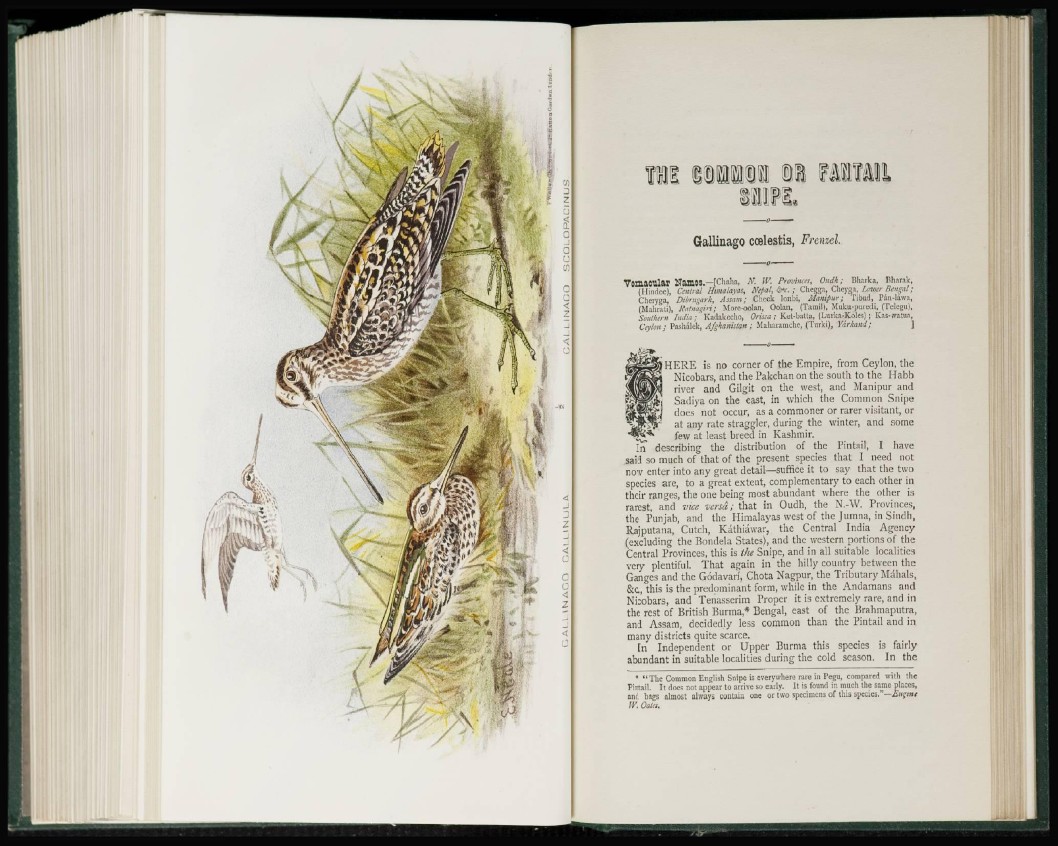
fit ©iiill ©I FAHTAli
Gallinago ccelestis, Frenzel.
Vernacular Names.—[Chaha, N. W, Provinces, Oudh; Bharka, Bharak,
(Hindee), Central Himalayas, Nepal, &>c. ; Chegga, Cheyga, Lower Bengal;
Cheryga, Dibrngark* Assam; Check Ionbi, Manipur; Tibod, Pan-lawa,
(Mahrati), Ratuagiri; Moic-oolan, Oolan, (Tamil), Muku-puredi, (Telegu),
Southern India;' Kadakecho, Orissa ; Ket-batta, (Lurka-Koles) ; Kas-ivatua,
Ceylon; Pashdlek, Afghanistan; Maharamche, (Turki), Ydrkand ; ]
HERE is no corner o f the Empire, from Ceylon, the
Nicobars, and the Pakchan on the south to the Habb
river and Gilgit on the west, and Manipur and
Sadiya on the east, in which the Common Snipe
does not occur, as a commoner or rarer visitant, or
at any rate straggler, during the winter, and some
f e w at least breed in Kashmir.
In describing the distribution o f the Pintail, I have
said so much of that o f the present species that I need not
n o w enter into any great detail—suffice it to say that the two
species are, to a great extent, complementary to each other in
their ranges, the one being most abundant where the other is
rarest, and vice versa; that in Oudh, the N.-W. Provinces,
the Punjab, and the Himalayas west of the Jumna, in Siudh,
Rajputana, Cutch, Kathiawar, the Central India Agency
(excluding the Rondela States), and the western portions o f the
Central Provinces, this is the Snipe, and in all suitable localities
very plentiful. That again in the hilly country between the
Ganges and the Godavarf, Chota Nagpur, the Tributary Mahals,
&C, this is the predominant form, while in the Andamans and
Nicobars, and Tenasserim Proper it is extremely rare, and in
the rest o f British Burma,* Bengal, east o f the Brahmaputra,
and Assam, decidedly less common than the Pintail and in
many districts quite scarce.
In Independent or Upper Burma this species is fairly
abundant in suitable localities during the cold season. In the
* "The Common English Snipe is everywhere rare in Pegu, compared with the
Pintail. It does not appear to arrive so early. It is found in much the same places,
and bags almost always contain one or two specimens of this species."—Eugene
IV. Oaies.